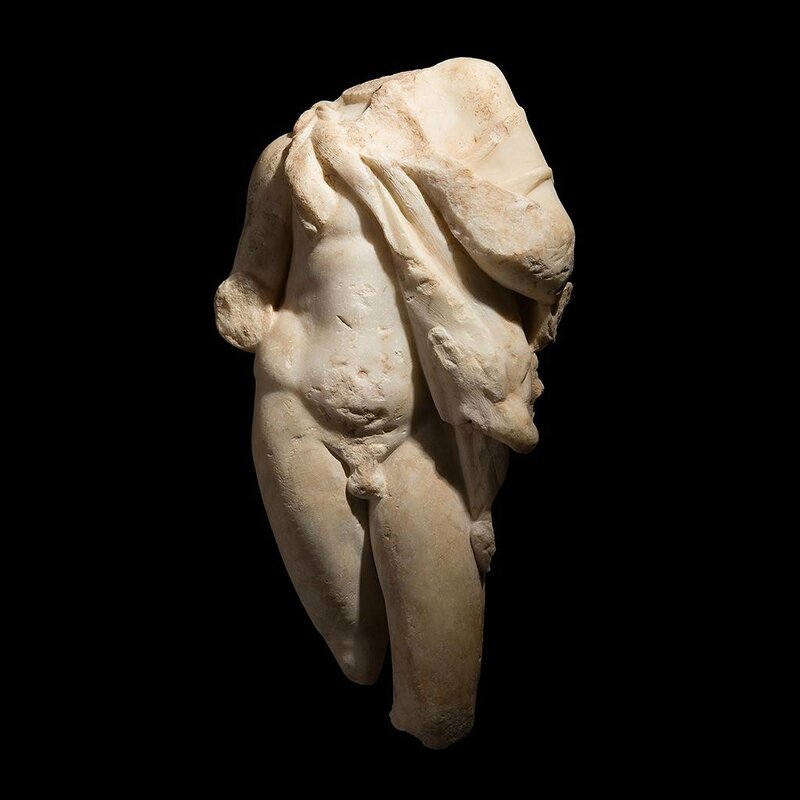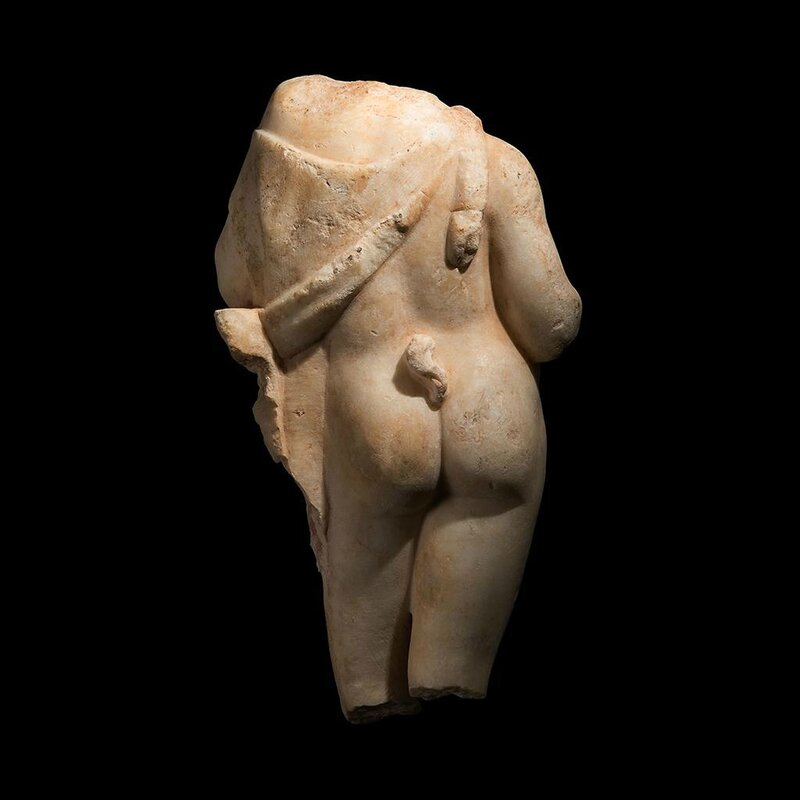Satyr playing a flute, Roman, 1st-2nd Century AD
Satyr playing a flute, Roman, 1st-2nd Century AD. Marble. Height 53 cm. Bagot Arqueología - Ancient Art at Brafa Art Fair, Brussels, 21-29 january 2017.
The torso and the thighs of the piece are those of a naked, almost childlike, young man. The only covering he is wearing is a goatskin tied over the right shoulder using the animal’s two back legs. One hoof falls down over the chest and the other down the back. The rest of the skin, serving as a cape, half covers the left shoulder and falls down the left arm, partially covering the torso. This attire, the fact that it is a skin, allows us to assume that the figure is one of a satyr. This deduction is confirmed by the fact that a small curly tail can be seen near the tailbone.
The movement of the body is particular, not like the typical “contrapposto” pose, where the weight of the body falls over the left leg, leaving the right slightly bent. This position gives a sense of movement, a degree of dynamism, to any naturalistic piece of sculpture in contrast to a front-on pose. But with this piece we see hips slightly to the right, leaving the right leg straight, while the left leg, with greater freedom, is placed in front and so forms a diagonal cross. In this position the weight of the piece falls on the right leg, but at the same time, the artist has placed a column on the opposite side, in imitation of a tree trunk, to support part of the weight and thus maintain equilibrium.
By studying different typologies of satyrs produced in the Roman period one can observe a notable relationship between this sculpture and a Roman copy of an original Greek piece, to be found in the Louvre Museum. The piece belongs to the famous Borghese collection. There is another similar one in the National Museum in Rome. They are similar in the position of the legs and also of the arms. The forearms of this piece in question are missing, but one can see in which position they would have been: the left one flat against the goatskin, reaching upward with the elbow bent, while the right forearm would have been further forward but also reaching upward towards the face from a bent elbow. Taking these deductions and the other pieces into account, it would seem that the hands would have been holding a flute. The only difference is in the positioning of the goatskin.
So the complete composition would have been that of a satyr leaning against a column, wearing a goatskin and playing a flute.
The satyrs, along with the maenads, made up the retinue that followed the god Dionysus. They were also associated with the god Pan. Some traditions consider Silenus to be the father of the tribe of satyrs. The three major members are Maron, Leneus and Astraeus. They were just like their father and therefore were also called Sileni. According to some versions of the myth, these personages were the fathers of the satyrs (and therefore Silenus would have been the grandfather). The three were in the retinue of Dionysus when he travelled to India. Astraeus was, in fact, the one who drove the chariot.
Provenance: Private collection of F. U., Munich, Germany, acquired at the beginning of the 1970s.
Bagot Arqueología - Ancient Art - Classical and Egyptian Antiquities. Consell de Cent 278, 08007 Barcelona, Spain

/https%3A%2F%2Fprofilepics.canalblog.com%2Fprofilepics%2F1%2F0%2F100183.jpg)
/https%3A%2F%2Fstorage.canalblog.com%2F03%2F02%2F119589%2F96711876_o.jpg)
/https%3A%2F%2Fstorage.canalblog.com%2F11%2F31%2F119589%2F94773502_o.jpg)
/https%3A%2F%2Fstorage.canalblog.com%2F20%2F83%2F119589%2F94772815_o.jpg)
/https%3A%2F%2Fstorage.canalblog.com%2F26%2F72%2F119589%2F75604929_o.jpg)
/https%3A%2F%2Fstorage.canalblog.com%2F59%2F60%2F119589%2F26458628_o.jpg)






/http%3A%2F%2Fstorage.canalblog.com%2F58%2F84%2F119589%2F129560262_o.jpg)
/http%3A%2F%2Fstorage.canalblog.com%2F31%2F36%2F119589%2F127772045_o.jpg)
/http%3A%2F%2Fstorage.canalblog.com%2F62%2F22%2F119589%2F122451290_o.jpg)
/http%3A%2F%2Fstorage.canalblog.com%2F18%2F49%2F119589%2F122383911_o.jpg)